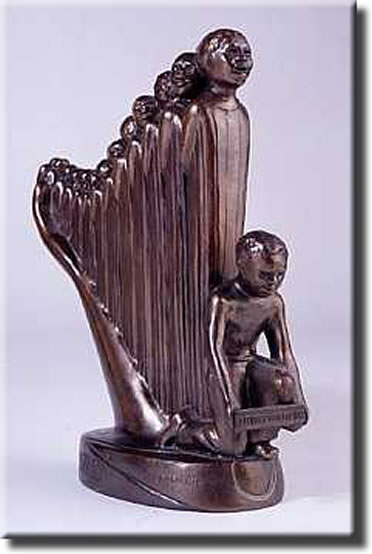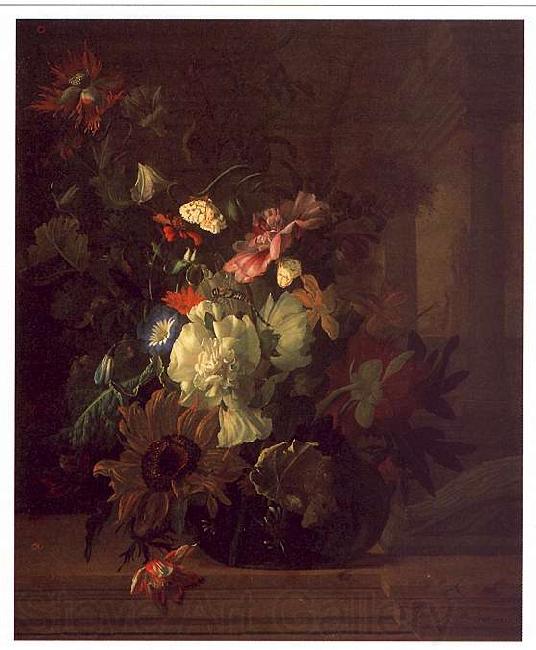Art as been around since the earliest times of civilization and has capturing the beauty of each time period. Many of the artist that we hear about are male like Picasso and Diego Rivera. But art is not all about males, we rarely hear about women artists throughout history. This make you wonder if the reason that women artist are not discussed in history is due to the fact that males are better artists? But this cannot be true because even the great Diego Rivera once quoted "Frida is better artist than I will ever be"(Diego Rivera). After attend the Brooklyn museum with my class my perspective on art changed. Prior to visiting the museum I had never heard of other women artist besides Frida Kahlo. I thought that art was mainly a male dominated field. But this tripped open my eyes and made me realized that women like Wangechi Mutu, Mary Cassatt, Frida Kahlo posses artistic talents that are equal to the great male artists of all time.
One of the artist that caught my attention at the Brooklyn museum was the women artist from Kenya, Wangechi Mutu. The Brooklyn museum describes the paintings by Wangechi Mutu as "it scrutinizes globalization by combining found materials, magazine cutouts, sculpture, and painted imagery"(Broolyn Musuem). This modern female artists work is absolutely stunning and have the chance to see it in person was unreal. The most interesting painting that i came across was "Riding Death in My Sleep".
 |
| "Riding Death In my Sleep" Wangechi Mutu |
Another women artist that I would like to mention that I found very interesting would be Frida Kahlo is by far my favorite artist partly because she is of Mexican decent like myself. Frida's work was mainly self portraits and with symbolism that related family or her life. Frida's story is very inspirational and in Mexico it has become legendary. I remember at a young age my mother telling my stories about Frida and taking me to a musuem in mexico that has Frida's work on display. Just seeing her work in person made me realize how talented of a person that she really. Many of her works often depict pain or sorrow. The bright colors and traditional clothing worn by Frida in her paintings express her culture.
 |
| "Henry Ford Hospital, 1932" |
Another artist that I would like to discuss would a women artist during the 1930s Augusta Savage, was an African American women artist, who was a sculptor during the 20th century. Savage was born on February 29, 1892, in Green Cove Springs, Florida, and original birth name was Augusta Christine Fells. Augusta died on March 26, 1962 in New York, New York. "Augusta Savage was one of the few visual artist involved in the previous decade's cultural movement known as The Harlem Renaissance and one of the most influential artist working in New York's Harlem" (Chadwick 316). Savage fought for African American artist like herself to be included in the organization called "WPA". Besides fighting for the rights of African American artist, Savage "became an instructor at the WPA-supported Harlem Community Art Center and a major force in training of younger African American artists" (Chadwick 316).
"The Harp"
 |
| http://www.1939nyworldsfair.com/worlds_fair/wf_tour/zone-2/the-harp.htm |
The last artist that I would like to mention would be Rachel Ruysch (1664-1750). This women artist was the daughter of a professor of Botany and was the apprentice to a flower painter. Ruysch was a member of the Pinter's Guild in the Hague and was married to a portrait artist. The couple was blessed with a 10 children. For many the cost to maintain 10 kids would be to much but not for Ruysch who specialized in painting flower portraits. Ruysch was swamped with commissions for her flower paintings due to the fact that flowers were very important subject in Holland and Ruysch was paid more than Rembrandt. Below we can see one of Ruysch flower Portraits.
 |
| Still Life of Flowers |
In this painting by Ruysch we can see that the artist has chosen to express her art, by painting a flowers in a vase. Ruysuch choose to express her art in a form of flowers because she "assisted her father decorating the prepared specimen in a liquor balsamicum with flowers and lace" when she was younger (intofineart). Ruysch uses dark colors in the background as way of bring out or putting more emphasis on the flowers. The flowers on the other hand have bright colors in the painting to put more emphasis on them. Many know Ruysch paintings because for their degree of accuracy and the realism of the objects in her paintings"(Painting Analysis).
The visit to the Brooklyn Museum was eye opening and very interesting. But one significant piece of art really took my breath away. This breath taking piece of art was the "Dinner Party" that we viewed in a dark room at the museum. It was magnificent to see a piece of art that took years in the making, right in front of me. The dinner table is triangle shaped and has seats for "thirty-nine guests of honor, mythical and historic women whose accomplishments were largely erased from male-dominated histories, are represented by individually symbolic, china-painted porcelain plates and intricately needle worked table runners"( Brooklyn Musuem). The first few plates that we see are of simple designs but as we progressed around the table we saw that each plate became more 3-D. This symbolizes how women's art has progressed through the years. The Dinner Party, was painted by Judy Chicago and it is her most famous art project, "A monumental testament to women's historical and cultural contributions, it incorporated sculptor, ceramics, china painting, and needlework." (Chadwick, 376)
 |
| "The Dinner Party" Judy Chicago |
All the artist that were discussed have some sorta of relation with one another. Judy Chicago, Frida Kahlo, Agusta Savage, Rachel Ruysch and Wangechi Mutu all have challenged the roles of their society. Each female artist has done controversial in order to make push women forward in the society dominated by men. Kahlo proves that greatness is only achieved by push passed your boundaries, even when Frida was sick she pushed forward and made art that was highly controversial at the time. Both frida and Savage prove to us that change does not come to those who wait around. It comes to those who make an effort and stand up for what they believe is right. Mutu, shows us that problems of equality still exist and need to be addressed in our society. Finally Judy Chicago addressed all of these societal issues by showing the strengthen and determination of feminism come to those who work hard and demand change. All these women have proved that change only happens when people take action and push the boundaries. Just because things goes go against what is normal does not mean there wrong. Just ask Mutu who has made numerous paintings that are consider "not normal". But at the end of the day it is still art.
Works Cited
http://www.brooklynmuseum.org/exhibitions/wangechi_mutu/
"Diego Rivera." BrainyQuote.com. Xplore Inc, 2013. 2 December 2013. http://www.brainyquote.com/quotes/authors/d/diego_rivera.html
"Augusta Savage." 2013. The Biography Channel website. Nov 07 2013, 11:13http://www.biography.com/people/augusta-savage-40495.
Chadwick, Whitney. Women, Art, and Society. 4th. New York: Thames & Hudson, 2007. Print.
RC Templates, ed. Agusta Savage. Melissa Moxley, 8 Dec. 2011. Web. 7 Nov. 2013.
<https://sites.google.com/site/newdealartmuseum/gallery/agusta>.
T. R. Poston, "Augusta Savage,"Metropolitan Magazine, Jan. 1935, n.p"
http://intofineart.com/htmlimg/image-03695.html
http://www.painting-analysis.com/rachel_ruysch.htm
No comments:
Post a Comment